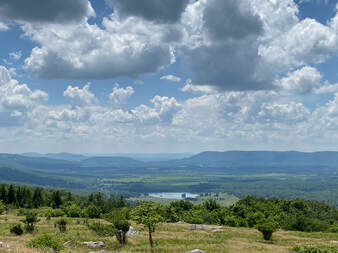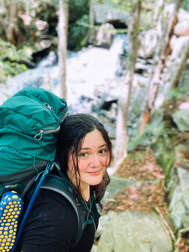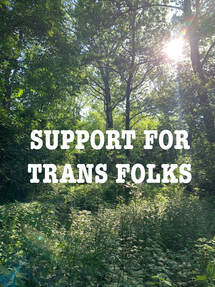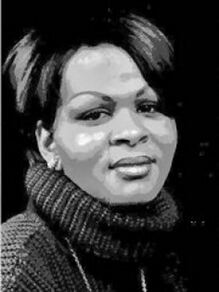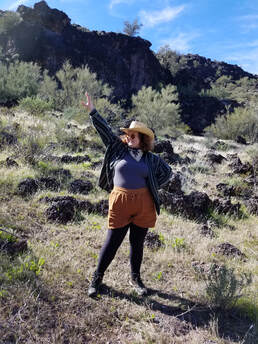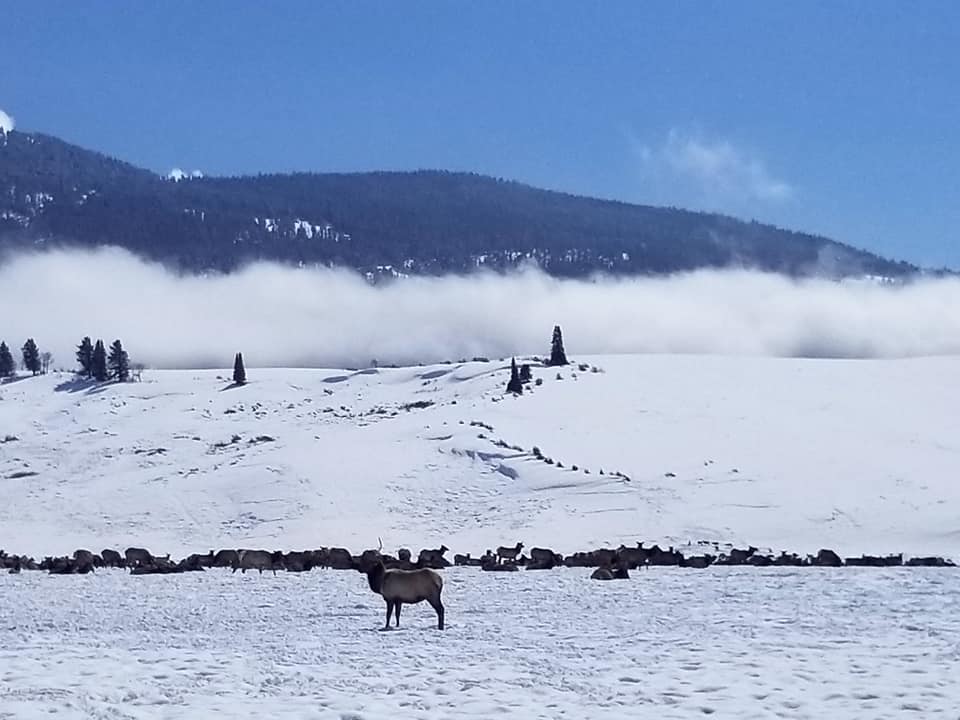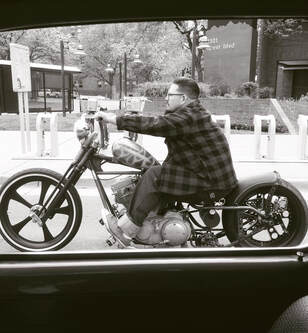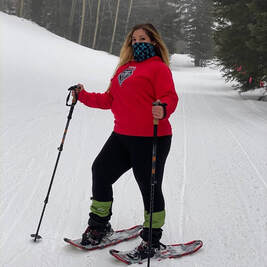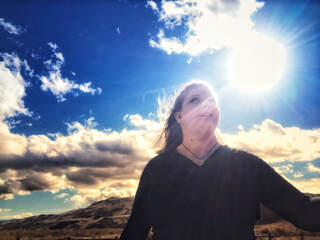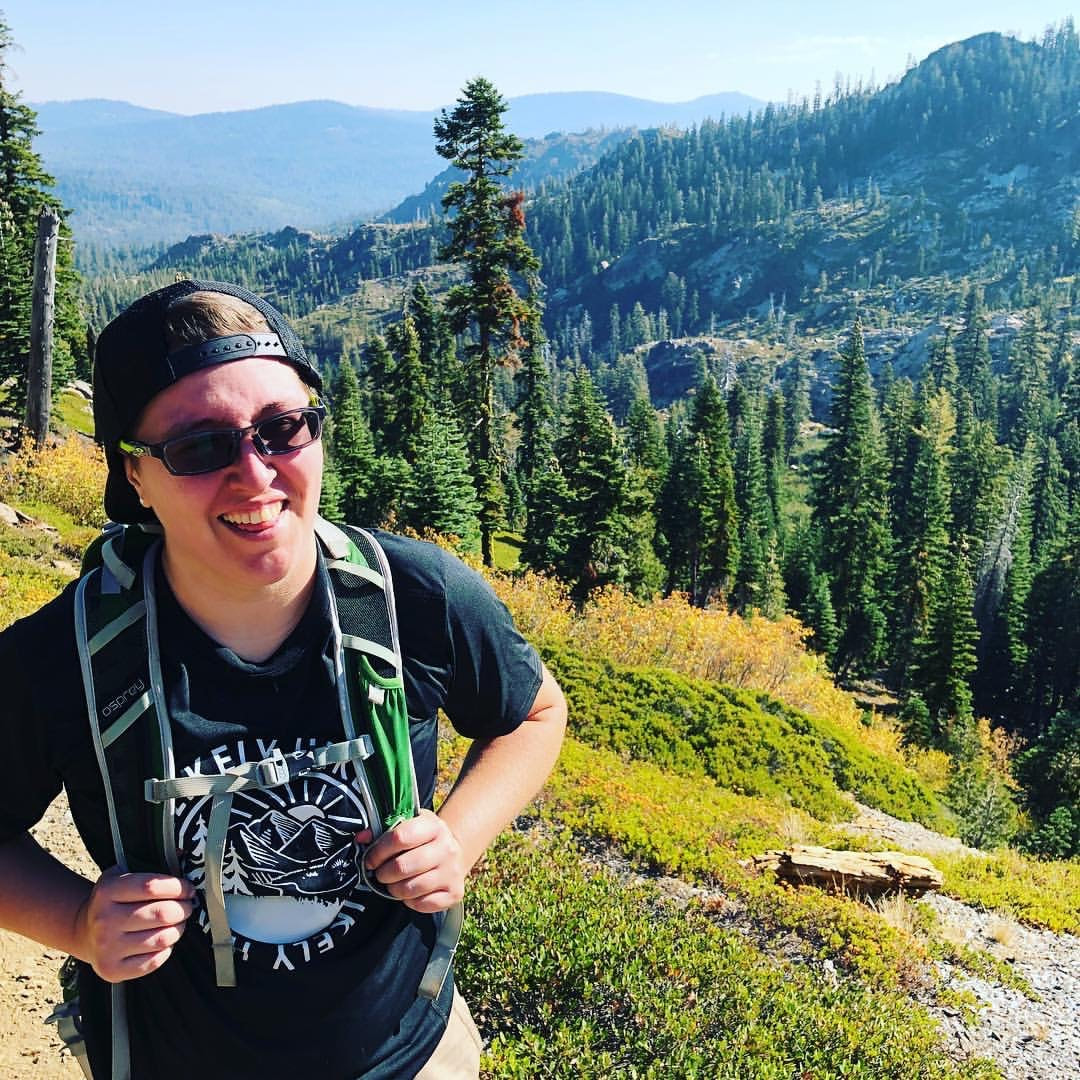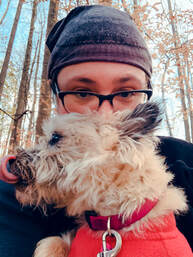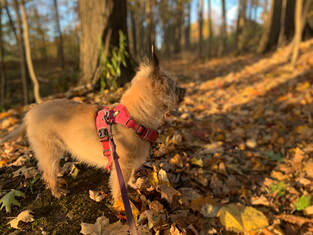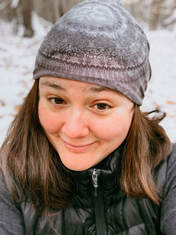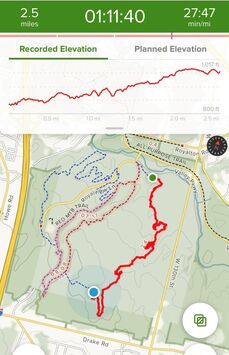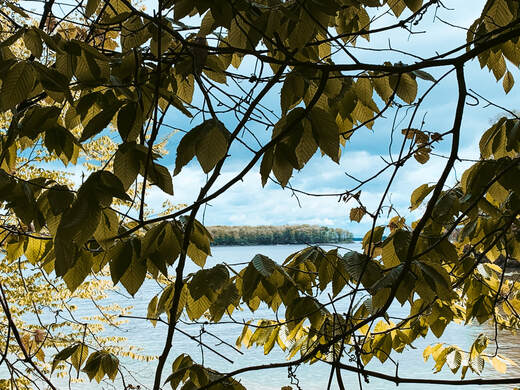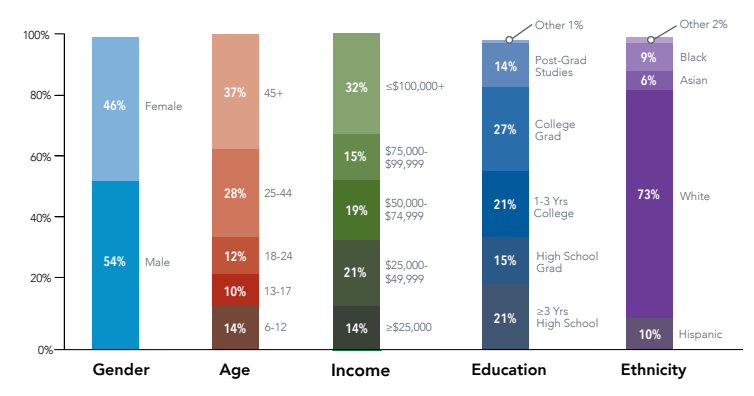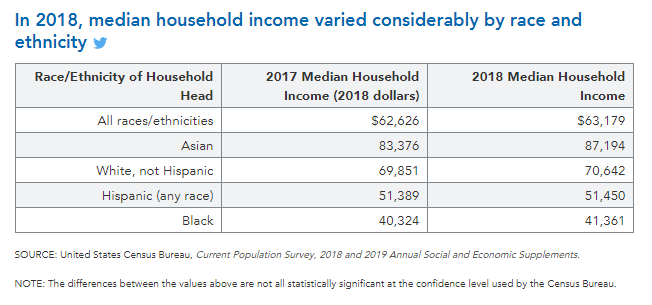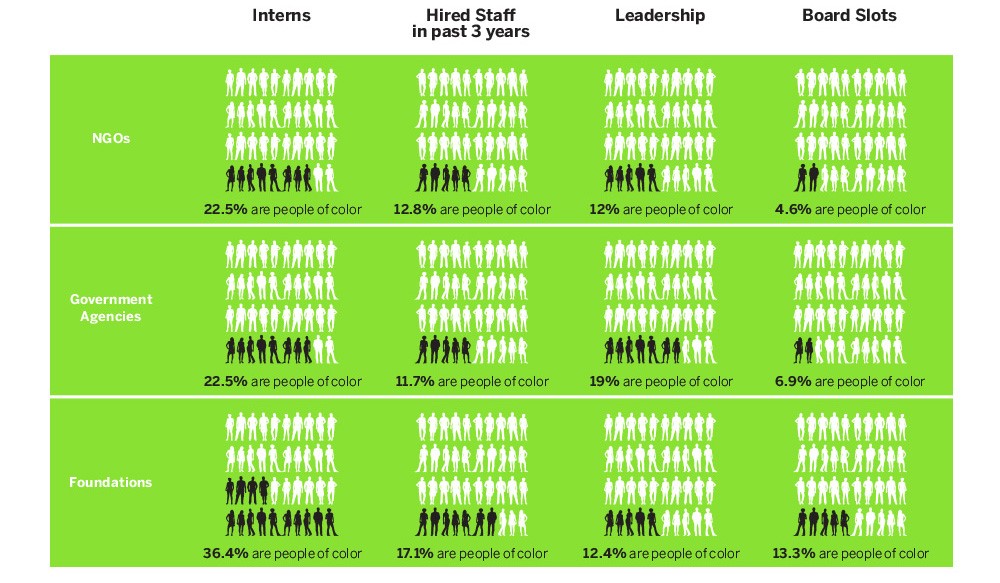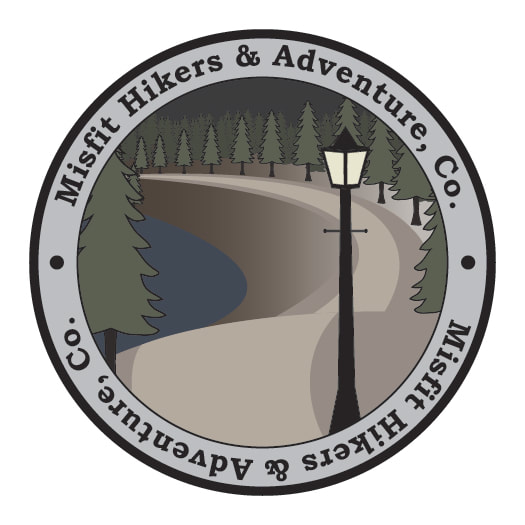|
Who wants to miss out on views and experiences like this, all because they can't find someone to go with them? There's already enough obstacles so many face in getting out to enjoy the outdoors, why should our fear of being alone and what could happen be one of them? Last post I wrote about the fear of being out there, and that the chance of being attacked (by a person) on the trail was actually extraordinarily low. But when you're out alone, there ARE some precautions you can take to help keep yourself safe - against people, loose dogs, injuring yourself, etc. (note: always read up on the wildlife on the area and prepare accordingly). So read on for some of my own tips and tricks, as well as some from my readers as well!
DO: - Step off the trail when possible to let folks pass, so you have full view of them. - GPS/Life Link through All Trails - I have a Garmin InReach, which has an SOS button which summons search and rescue, and I can text my family (with coordinates) when I don't have cell service. This is GREAT if you hike alone, where the danger of twisting an ankle or falling means you could need some help. - A lot of people said get a dog - this is an inbetween for me. Dogs can be a great protector, but they can also cause problems if in a dangerous situation (I'll do a separate post about this). I have a dog. I'd rather take my chances than leave my boo home. - Mace/Pepper Spray/Bear Spray - I carry bear spray now at all times, because loose dogs. It's in a holster on my belt. If you carry mace or something similar, then keep it handy - around your neck, wrist, etc. NOT in a pocket, and PRACTICE pulling it out! - Use hiking poles - not only will they save loads of strain on your back and knees, but handy to beat away dogs. They also keep you from slipping and injuring yourself. - Trust your gut - if you feel uncomfortable, get out of there - Take a self defense class - Carry a weapon - if you're going to carry a weapon - from bull whip to knife to gun to stun gun - you need to be experienced in its use. A few hours at the range doesn't count. I mean, I saw a dude running on rocks with an ax at Dolly Sods. Don't do that, my guy. In fact, because it gives you a false sense of security, you may ignore other safety measures that have significantly more impact. - Snap a pic - sometimes I'll be in a parking lot and there will be someone waiting in a car, which is normal but always weirds me out, so I casually snap a pic of them/license plate and send to husband. - Tell someone where you are going and when you should be back. EVERY TIME. - Find a way to quiet your mind - Look, a lot of the fear you feel out there about being alone and what can happen is just that...fear. It's gonna hamper you, and the anxiety can be intense. Find a way to distract yourself - I listen to books on tape (no earpods or just one!!). There's music, talking to yourself, reciting a poem over and over (mine is "he thrusts his fists against the post and still insists he sees the ghost). DON'T: - Don't wear earbuds - or only one earbud - you need to be aware of your surroundings. - Don't be afraid to move on from a conversation - you don't owe anyone anything on the trail. If you aren't comfortable showing a solo-guy on a map where you are, then don't. - Don't randomly meet up with someone from the internet, because you think hiking with a stranger is safer than hiking alone. Even if a woman, be careful, do your research and meet up ahead of time to check them out. JUST BECAUSE THEY ARE FEMALE DOES NOT AUTOMATICALLY MEAN THEY ARE A SAFE STRANGER. - Don't park next to cars in the parking lot if you can avoid it. And ALWAYS be aware of your surroundings in the parking lot. Don't be distracted here. The chance of being injured by someone on the trail is extraordinarily low. SO LOW. When I say low, I mean LOW. I had trouble finding any cases at all - really only a handful. Folks are more likely to run in to someone in the parking lot (STILL very very low). Folks are definitely more likely to encounter a loose dog or trip and fall. Be prepared for those situations. In the end, the more you do it, the more comfortable you'll be. It's natural to feel scared and unsure in the woods - we're taught that being alone is a bad thing and from the time we're kids that the woods hold monsters. Coupled together and WHAM! But while you should be careful and respect your surroundings, you shouldn't let it stop you from getting out there. If I - who has an imagination that goes WILD - can hike in the dark and even do solo trips - can do it, then YOU. CAN. TOO. Any other tips and tricks of the trade? I know there's more!
1 Comment
The other day, a woman in the hiking fb page I'm part of made a post about being frightened on the trail when she's by herself and asked how others stay safe. Probably a doze or more other women said they also really want to get out and hike, but they are scared to do it alone.
. Lots of folks chimed in, with lots of helpful tips. Nearly all the men (and a few ladies) said get a gun. Let me say this - I have no issues with gun ownership. However, very few folks out there are going to be well enough trained to pull a gun under duress/surprise attack and be able to shoot it accurately. I don't carry a gun because, frankly, I'm clumsy and I'm much more likely to get a twig stuck near the trigger and shoot myself. I read somewhere once that under a 100 hours on the range and don't even bother. . After doing some reading, carrying a gun without significant training and practice can also lead to a false sense of security. You have the gun, right? So folks often become lax in keeping up their other safeguards. . And while a number of guys chimed in that they, too, were scared when they first started hiking alone (kudos!), I was surprised to see woman after woman posting. So why so many women? Well, let's be real - society teaches women that it's dangerous for us to go out alone. Rape culture, right? Carry your keys, be aware of your surroundings, etc. It's a real thing. There's safety in numbers. Add the visceral fear humans have of the unknown AND being alone in the woods, and it's easy to see a stranger waiting to hurt us behind every tree. . What's also real, though, is (taken from the Bureau of Justice Statistics): - Females are generally murdered by people they know. - In 64% of female homicide cases in 2007, females were killed by a family member or intimate partner. - In 2007, 24% of female homicide victims were killed by a spouse or ex-spouse; 21% were killed by a boyfriend or girlfriend; and 19% by another family member. - In an additional 25% of cases in 2007, females were killed by others they knew. An estimated 10% of female murder victims were killed by a stranger. . I tried to google information about crime/attacks on women in National Parks, and frankly couldn't find any (I kept getting information about bison and bear attacks). I tried local state parks in Ohio, and came up with a grand total of 3 instances over forty years - a man with a mask approached a jogger on a trail, but she ran past him; a woman was murdered in a parking lot by someone she knew; and two children were taken to a park from elsewhere and killed. Horrifying. . There were other instances of violence in some urban metropark parking lots, but they involved those that went there for things other than hiking (drug deals, etc.). . Random attacks by strangers in rural areas is lower than those in urban areas. Can something happen on the trails? Sure, of course. Yet, throughout the day, we still walk to the store, go to the movies, take our kids to the park...go about our every day lives. And as we do, most of us don't actually take any precautions at all. We don't even think about it, if it's daylight. . I'm not downplaying these instances or fears by ANY means. But I do believe that you can be a woman (or man) and enjoy the trails on your own, without fear, by taking good safety precautions. We should make sure that our fear of being alone on the trail is proportionate and appropriate, not paralyzing or preventative. We're going to talk about these precautions later on this week. They're also good against animals, too, because to be honest you're more likely to have a run in with wildlife than a person. . Have a tip for safety on the trails when out there alone? Leave it below! There's a lot of trans folks that follow Misfit Hikers. Transgender people face a lot of discrimination, particularly in hetero/cis, alpha white-male dominated outdoor world. . They face discrimination and hate - from access to housing and restrooms, to inadequate healthcare and hate-crime support. . In 1995, Tyra Hunter was in a car accident. And when the EMTS discovered she was trans, instead of helping her they called her derogatory names and refused to treat her. She was finally taken to a hospital, where the same held true. She died, suffocated to death. And it was completely preventable. She was murdered through inaction. Her death was a rallying cry that lead to significant change for transgender people in the healthcare world. (Not NEARLY enough, though). .
On June 6, 2020, President Trump signed an executive order revoking discrimination protections for transgender people seeking healthcare. It's to go in to effect mid-August. . This administration has actively and continuously sought to dismantle the protections and persecute those in the #PridePack. In the midst of a pandemic and in the wake of a better supported and acknowledged #blm movement, this executive order is particularly insensitive, damaging, and demonstrative of his agenda. How can those that are transgender feel safe in the outdoors, when they aren't safe on the street? . To my transgender followers, I'm sorry this is happening, and please know this is a safe, supportive space. You are important to the outdoors and your voices are heard here. If you need additional support during this time, there are many resources for you to take advantage of, these are just a few. If you aren't trans, but want to better support a transgender person in your life, here's a good place to start. If you have others, please feel free to comment below. **Misfit Showcase!** (megan_sykora)
. I am a misfit hiker because I am fat, I am a woman, and I struggle with depression, anxiety, and ED. . The outdoors have been a part of my life since I was a kid, hiking and camping with my family. As I grew up, being outside became a challenge and a taunt, because I longed for an adventurous life that I believed (and was told) I was too fat to have. I never felt welcomed in the outdoor communities. This past year, however, I've become reinvigorated by many things - the fat liberation movement, friends and family, and the things that bring me joy, most notably hiking and biking. Being outside is a private time for me, when I contemplate and discuss things with myself, and when I am most free to feel joy. It is also where I feel most valid as a human being, equal to every other. We all have different physical abilities and different stories, but nature doesn't know or care. It is beauty and life, two things I'm trying to focus on most.- Megan (@megan_sykora) . Pronouns: She/Her . Tag #misfithikers to be showcased! . [Image Description: Megan stands, wearing black leggings and salmon-colored shorts, with a black shirt and long-sleeved jacket. There's a cowboy hate on her head, and she dons sunglasses as she points to the sky. Her curly brown hair touches her shoulders. In the background is thick scrub, and dry grass and bushes lay all around her. The sky is blue with wisps of clouds.] How is COVID-19 affecting National Parks and those that make them their livelihoods? My good friends Jeremy and Emily were in Wyoming, visiting Grand Teton and Yellowstone. Jeremy offered this perspective on what it takes to maintain nature: "A moment to reflect as we leave this wintery wonderland and return back to the reality of a COVID-19 world. We may be facing unprecedented challenges with social systems, with our supply chains and economy. In Jackson Hole we met many people whose lives are about to fundamentally change. Being in the tourism / hospitality industry they are facing massive layoffs with no hope of alternative employment or unemployment compensation. Many are leaving, as the rent prices are close to that of Seattle. The Commercial properties are closing permanently as they cannot afford $60k a month leases. This all puts into perspective what it takes to keep wild areas wild, even in the current commercialized world where you can visit national parks on a whim. This may not be the case in the future, or there won't be as big of an industry around it.
. Enjoy nature as you can. Stay safe as you do, and if we end up with quarantines of course follow them, but until that happens - you'll find us in the woods." . Pronouns: He/Him and She/Her . Wyoming - This land originally held in stewardship by the Arapaho, Arikara, Bannock, Blackfeet, Cheyenne, Crow, Gros Ventre, Kiowa, Nez Perce, Sheep Eater, Sioux, Shoshone and Ute tribes (and possibly others). . Pics Courtesy of Jeremy. . Have you noticed changes in the outdoors and outdoor spaces due to COVID-19? “Lonesome lobo. Rockabilly. Lowrider. Oldies all day. Greaser. Mechanic. Mack trucks Chicano. Honky tonker. Vegetarian. Buddhist teachings. Hiker. Traveler. Animal rights. Colorado. Cali. Tattoo luv 🖤. Found my biological father and family 2 years ago at the age of 41. Amazing story there. Highly impacted over last few years by a massive brain tumor. Radiation in 2018-19 and serious side effects. With the luv of friends and family, I healed and moved forward changing my world. I still have to perform MRI’s every 6 months as long as I live to monitor the brain tumor. And at the same time I’m pursuing my passions. On day one, NOT one day. Lost 80lbs. Active every single day. And learning so much of the hiker life and enjoying hikes religiously with just the sounds of nature. Life is short and beautiful. Embrace the day. Embrace your close ones. And embrace yourself 🖤. — (Maurice, @Lone_some_lobo)
. . Pronouns: None (El Lobo) . . [Image Description: Maurice rides a drop seat, custom motorcycle on a paved road, with trees, a sidewalk, and signs in the background. Maurice wears a plaid, long-sleeved shirt, jeans, and sneakers. Maurice wears glasses and has a moustache and goatee.] “I've always loved the outdoors. As a child my family would take a few camping trips every summer. It wasn't until I was much older when I found my passion for hiking. The very first time hiking was actually on a date. I am a bigger girl so I was concerned that I wasn't going to be able to keep up or that I would be huffing and puffing and just have a miserable time. I was wrong! We did a pretty short hike but it was still challenging enough. I was huffing and puffing a bit lol, but honestly I didn't care because I was having so much fun. On that day not only did I find my passion for hiking but it also jumpstarted my passion for photography. Nothing ever ended up evolving with the guy I went on a date with, but I am grateful I went and that he introduced me to a hidden passion. – Angelica (@thethickhiker)
. Pronouns: She/Hers . Tag #misfithikers to be showcased! . [Image Description: Angelica stands on a snow-covered path with pines in the distance, wearing a red long-sleeved shirt, black tights with green at the bottom, and a black patterned buff across her face. Her brown hair hangs long and loose. She's holding skis/trekking poles and wearing snowshoes. ] 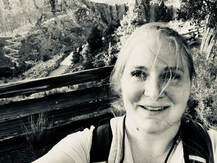 “I am overweight. I have had 13 surgeries in the past 15 years. I struggle with bipolar, borderline personality disorder and social anxiety. The trails have saved me from myself, they have brought me closer to my husband and pups, and I’m starting to be more comfortable being in social situations. I still take meds, but less of them thanks to nature. And I’m not ashamed of that. I am a misfit hiker who has been saved by the trails and the trees.” – Nicole (@cardinalroots) . Pronouns: She/Hers . 📣Nicole would like to give a shout-out to: Hiker Babes Central Oregon! (@hiker_babes_oregon, #hikerbabesoregon) . Click here to be showcased! . [Image Description: Pic 1 – Nicole, smiling in a black long-sleeved v neck shirt with a black string necklace and medallion, stands looking towards the sky with puffy white and golden clouds behind her, mountains in the distance. The sun gleams in the right corner. Pic 2: Nicole grins at the camera, wearing a white t-shirt and black-strapped backpack, in a sepia/black and pic, shot on a wooden-railed bridge, with water below in a canyon, trees and shrubs all around.] *MISFIT SHOWCASE!*
“Hi. My name is Shaun. I’m a misfit all around. I believe boxes are best for cats not for humans so I am myself 100% of the time. I struggle with drug resistant severe depression and anxiety. I try to find the positive and the humor in everything. When I’m not working (I manage a Tea bar where the workers lovingly refer to me as “dad”) you can definitely find me outside. It’s where I feel most happy, free, and at peace. I hike, skateboard, trail run, and explore (both solo and with friends) and have for as long as I can remember. My philosophy in outdoors and life is “you do you!”—Shaun, (@Dykesonhikes) . . Pronouns: she/her or they/them . 📍 Chico, California – This land was originally held in stewardship by the Mechoopda Maidu peoples and others. . Tag #misfithikers to be showcased! . [Image Description: Smiling in sunglasses and a black t-shirt with a white “Unlikely Hikers” t-shirt, Shaun stands clasping a grey and black backpack shoulder straps. Behind her is a vista of scrub brush, and tall pines and mountains can be seen in the background.] The pain is just in your head...that's how I felt when I went to the Cleveland Clinic downtown ER just over a week ago. The doc implied I was in pain because I was fat, had over-exercised, or that I was simply drug seeking. It was such an awful experience that I wanted to see if I was the only one. I felt very much alone and I started to doubt myself which I rarely do. Then I started reading. And holy shit. Sorry not sorry for the length of the post. It's important shit, and if it's 400 words over what people will typically read, well, if you can make it through a Stephen King novel, you can hopefully hang on long enough to make it through here.....
This isn't made up - it's a valid problem, as reported on by the NY Times, Harvard Health, and the Washington Post. So what's happening? Well, unfortunately, if you aren't a white cis male and in pain, good luck:
Why? Why does this happen? You can't ignore that white cis men have certain societal privileges, leftover from a thousand years of being the top dogs. I have nothing against white cis males - my problem is with the people that afford them the privilege at the expense of others. There's a historical connection that can't be ignored - for example, studies have shown in the case of women, doctors are much more likely to assume women’s pain is caused by emotional issues and/or hysterics rather than rooted in actual physical causes. EVEN WHEN CLINICAL TESTS CLEARLY DEMONSTRATE THEIR PAIN IS REAL AND IDENTIFIABLE. Not only that, but women with emergent or chronic pain are much more likely to be misdiagnosed as having a mental health issue and prescribed anti-anxiety or psychotropic drugs. I guess that's progress from the forced masturbation doctor's prescribed in the 1800s. Additionally, lady folk with biologically female issues in the ER and out of the ER, who complain of pain associated with fibroids or endometriosis are still often dismissed in high numbers as having pain “normal to being a woman.” It boils down to doctors believing women are more emotional and irrational than men, and so over exaggerate their pain, if they are actually having pain at all. This isn't anecdotal - Karen Calderone, for example, found doctors tend to treat men and women differently when they’re in pain, even when they exhibit the same symptoms. And they’re given sedatives instead of pain-managing drugs. Because the pain is in their head and will go away if they get their hysterical vaginas under control. WTAF. The internalized discrimination is immense in the medical community. In 2016 nearly 50% of those medical students and residents surveyed believed at least one myth regarding race and pain – like believing black people had nerve endings that are less sensitive than whites. Uh, what? Like, what the what? Doctor’s also erroneously believe that women and persons of color are more likely to become addicted to painkillers, because they’re more likely to abuse them. And these are only a few examples. If you’re attractive? Ha. Good luck to you. The ER is one place that shit will work against you. Why? Because is you’re pretty on the outside, it means you’re healthier on the inside and therefore you’re less likely to be treated for serious health issues. Yikers. Basically, unless you’re a white, heterosexual male, you’re kinda fucked. Older? Told the pain is part of aging and to suck it up. LGBTQ? Hysterical. Children? Whiney. The list goes on. So what kind of ramifications does this have? The answer is….a lot. Medical research on women lags behind, and it's killing us - A study published in 2000 by The New England Journal of Medicine found that women were SEVEN TIMES more likely to be discharged from an ER in the MIDST OF HAVING A HEART ATTACK. Why? Because all the studies on heart attack symptoms are done on men and women have different symptoms. What about abdominal pain? Head pain? Back pain? Pain is an indication that something is wrong. Get the pain under control and then figure that shit out. Don’t send us home. Don’t ignore us. Don’t patronize us. When you do, we live in pain and illness much longer than necessary. Sometimes, it's never treated. Women and persons of color are also less likely to seek medical attention, out of fear of being dismissed or ignored. So the problem worsens. Or we just die. I run a group for misfits - those that don't fit the stereotype of the "typical" outdoor person. Outdoors adventures. Sometimes we're going to get hurt. Sometimes we're going to have chronic problems and/or pain. We also deserve to be cared for, to be treated in a fair and equitable way. When you don't, you further limit our access. Stop it. I posted what happened and I've now looked in to why it happened. Next up, what can be done? It's not enough to complain, I want to find solutions. What do YOU think people can do? What the solution is? Post below or contact me here.
I don't like to hike in fear, but I do like to hike in safety. Why get a satellite communicator? Cause they're fucking awesome. And not just for hiking - they're great for anytime who might be in a remote area and not have cell service. I couldn't find the article (of course), but I'd read something like 60% of SOS calls from satellite locators are by people that have been in a car accident. Legit. They aren't just for hikers, but joggers, walkers, anyone that's gonna be outdoors....
Sample Uses:
What They Offer: Varies drastically depending on the model.
Biggest Downside - Price. They're a chunk of cash, ranging from $150.00 up to $1200.00 and beyond. On top of that, you have to get a subscription. The plans range in price, depending on what features you want - I have one that costs $11.00 a month. I'm big on access - and safety - for everyone. And these are prohibitively expensive for many, even with sales. I don't like the idea that because people can afford this, they're safer on the trails. Other Downsides: They don't really work in caves and inside homes. They can also get a bit sketch if the sky is occluded (heavy tree coverage, etc.), but most models have a means to continually attempt to send the message until it gets through. If you're thinking about getting one (they're hella on sale with the holiday), check out this article from REI on selecting the best one. Over the next week or so, I'll be reviewing the Spotgen 3 and the Garmind InReach Mini. One is amazing and one is....not. Do you have a satellite communicator? Love it? Hate it? Ever had to use it? Comment below or email me here!
"Lots and lots of Vitamin I," a guy replied (laughing) to me the other day, while we were chatting at the physical therapist's office, after I'd queried how he kept up his really intense workout regime with the type of injury he had.
Inwardly, I cringed. Bigly. What's Vitamin I? It's what outdoor folks (particularly thru hikers and hikers) fondly call Ibuprofen, an NSAID, and it's no joke. What's an NSAID? It's a lovely anti-inflammatory drug you can buy over the counter at any pharmacy - it's great for pain and marvelous for inflammation. It's not a steroid and you can buy it everywhere, so it's safe, right? Wrong. When my back injury occurred, the docs started me on large doses of Vitamin I, which I was on for weeks - which totally destroyed my stomach. As in I can't eat the same way I used to, I have a lot of pain with it, and I have had to change how I do things because of it. It's greatly affected my everyday life. There's been a lot of studies, and you can read an overview of them at Time, the Cleveland Clinic, the Mayo Clinic, and Harvard's websites. So what are the risks of NSAIDS? - The heart - increased risk for heart attack by 1/3 (though Ibuprofen more than doubled those risks).....and 19% increased risk of being hospitalized for heart failure - intestinal bleeding - increase chance of stroke - increase change of hearing loss (by 10%) - greater chance of bone loss with resistance training But you only take them occasionally in low doses, so that's fine, right? Nope. You can mess your heart up only using it for less than a week - though long-term use and higher doses increase the risk. Even scarier - they don't know why it increases the risk of a heart event. WTAF. Sometimes, you may *have* to take it, to get some sleep, especially if you manage chronic pain. Don't feel bad about it!! - take the lowest dose possible - don't take more than one kind of NSAID at a time, it increases the danger What if you have chronic, painful inflammation and don't want to take "Vitamin I" any longer? Look for my post next week, where I'll write about some of the wonderful alternatives out there to help deal with inflammation. Because being in pain sucks, and it keeps you from doing the &^%$ you want to do. Do you use NSAIDS? Any problems? How do you deal with pain from activities? Comment below or email me here.
One of the big problems getting started with outside adventuring has to do with access. Beginning hikers and walkers can find it difficult to determine if a trail they find online is appropriate to their ability, if they can even find trails around them. Once they find a trail, they want to know what the terrain is like and if there are any obstacles. Are trail bikes welcome? Horses? What about finding the trailhead? Navigating the trail? Any special wildlife areas they should be aware of, like bat habitats? Is it safe for their therapy or service animal?
I've had a number of folks the last few weeks ask what I use to gain access to the outside world, and my go to right now is AllTrails. Hands down, this is the best app I've found to give beginners - and experienced hikers - the access and information they need to get out in the outdoors. Six or seven years ago, I got lost on a Cleveland, OH trail. I had a printed map of the park, but the trails in the Metroparks aren't very well marked in most cases. It was cold and snowing. I had no cell reception and it was getting dark - of course I hadn't brought a headlamp/flashlight. The parks aren't all that big, so I knew I'd eventually find my way out. An hour after dark, my dog Charlie Chuckles and I made it back to the car. I was tired and reallllly pissed off. 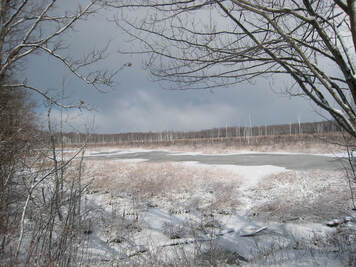 It was really, REALLY cold. It was really, REALLY cold.
And this wasn't the first time I'd gotten turned around on the notoriously ill-marked trails in the Cleveland area. Or been unable to find a trailhead with sketchy directions from the internet. Then came AllTrails. Queue rescue-themed music. AllTrails has been wonderful, and really opened up my access to trails in the Cleveland, OH and surrounding areas. Trails I doubt I would have found, or had the courage to try, without it. AllTrails is awesome - You can select what you want out of a trail and search for it - distance from your home, dogs allowed, length of hike, trail bike accessibility, difficulty, etc. This makes it a great tool for folks with disabilities that need to know if a trail is paved, if there are amenities at the trail head, etc. A nice bonus is that you're able to read reviews and see pics of the trail - great way to check for mud or other problems like downed trees/washed out trails. And it's free. Hiking and outdoor adventuring is already prohibitively expensive for many, and anything that removes additional spending is great (pro-version is $2.50 a month, and gives you access to download/print different topo maps). You can use it to track yourself AND record your hike while on the trail, even when your phone is in airplane mode. AllTrails also has a directions option that will open your phone's GPS app and take you right to the trail head. This is A-mazing. Previously, I found myself constantly lost on back roads, and a few times I even gave up on the hike. As a new hiker finding remote trailheads was incredibly frustrating. It helps build confidence, since you can view nearly all the trails immediately around you, allowing you to add/shorten your hike as you want or need to.
There are a couple downsides to AllTrails to keep in mind - it's not always 100% accurate in regards to length of the trail. I find the trails are often a half mile to a mile longer than indicated.
Keep in mind the difficulty rating of the trail tends to vary wildly. I did a 9 mile moderate trail last weekend, which was, to my surprise, easily and quickly accomplished even though it was pouring rain and I had to take a lot of breaks. Whereas I did a trail a few months ago that was five miles and very hilly, difficult terrain. Both were rated as moderate. I always encourage folks to have a printed map with them as well, and to understand how to read it, especially if you're in larger parks/national forests. Despite these issues, I recommend AllTrails for the access it provides. Have you ever gotten lost on the trail? Do you use an app or stick with a map, or both? Comment below, or feel free to contact me here! I'm sure many of you have seen the viral video of Amy Cooper calling the police on Christian Cooper, an African American bird-watcher who was enjoying the Bramble in New York earlier this week. She called the police because he asked her to put her dog on a leash (park rules). She says in the video, "I'm going to tell them there's an African American man threatening my life." She tried to use this man's race as a weapon against him. The outdoors is political, don't let anyone ever tell you otherwise. When I first googled top 25 hiking blogs of 2019, I was really surprised. The first several sites that listed blogs included very few women and I didn’t visually identify (or see in the descriptions) any minorities. Or people with disabilities. Or Pride Pack members. Or fat people. Everyone looked very, very white. I taught Diversity in America for quite a few years at several local colleges. I don't know why I was surprised at the lack of diversity in the online presence for outdoor adventures in the U.S., since there's a definitive lack of representation on trails. When my friend told some co-workers he was going backpacking for the weekend, his African-American buddy responded along the lines of, “Only in America would white people go in to the woods and pretend to be homeless.” It bothered me on a level that was difficult for me to define, because I view the outdoors as such an important part of who I am. It's a privilege. And privilege and access is a big part of the problem - because it isn't that way for everyone. The Outdoor Foundation, who conducted a survey in 2013, found that 73% of participants in outdoor activities were white, and 47% had an income above $75K (You can read the entire report on their website here.). And when whites in the U.S., on average, are the ones making that higher income, it's indicative of a problem and not just in relation to getting folks in to the great outdoors. Who's involved matters, too - from how outdoor events and activities are marketed to who runs the parks programs, you'll see primarily white people. The Green 2.0 Report demonstrates a clear lack of diversity in the government agencies, foundations, and NGOs that oversee outdoors recreation and upkeep: The world is a changing place, and it’s time for more outdoor activities, and the folks that are already involved in those activities, to change with it.
Race and ethnic minorities made up 40% of the U.S. population in 2016, and those numbers continue to increase. Consider the words of Teresa Baker, a contributor for The Bold Italic, when she wrote “The climate is changing, and so are the demographics of our country. What will happen when, in two to three decades, our new, non-white majority in the US doesn’t care about the environment due to a lack of involvement now?” While I fit the definition of a Misfit Hiker & Adventurer for a number of reasons, I am, in fact, white. So I come at this, clearly, from a very different perspective. I'd like to note that I am not here to define for anyone else what experiences they should have in the outdoor world or how they should feel about those experiences and/or interactions. However, what I can do, is try to make those outdoor spaces more welcoming. I can conduct and relate research in to different issues. And I can showcase others opinions, viewpoints, and experiences. Misfit Hikers is about inclusion and representation, and you're going to find a lot of emphasis on how people access (or don't access) the outside world of adventuring. And what actions can be taken to address identified issues. As a former teacher, I'm a big fan of education and considering other viewpoints - it forges a connection and helps shape how we view the world (and others). My very small first action is to start gathering resources on different topics regarding inclusion and representation in the outdoors. You can find the start of my efforts here. If you know of an article, website, Instagram, etc. that you'd like to see included, please comment! Or feel free to email me. What happened to Christian Cooper shouldn't ever happen. As stewards of the outdoors we need to - have to - do better. |
Archives
March 2021
Categories
All
|
